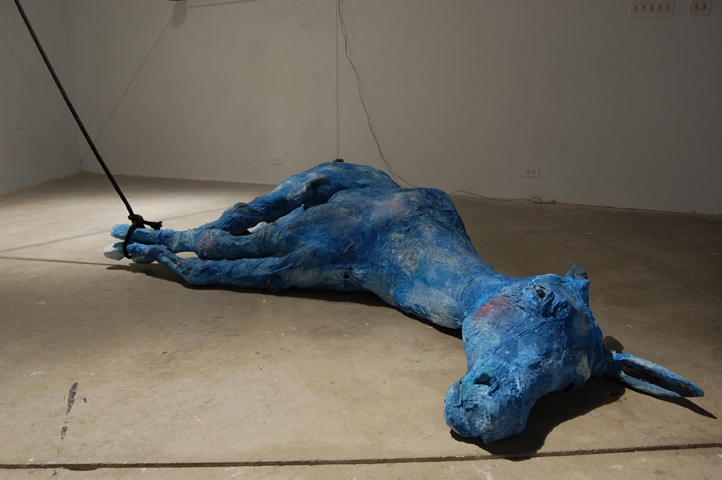Mia Feuer is a young Canadian artist currently based in Washington, DC, unknown to me except through her work. In the DC metropolitan area Feuer is probably best known for her proposed public sculpture Antediluvian, which would have depicted a petrol station partially submerged in the Anacostia River. The project was cancelled in 2014, following objections from a civic group devoted to improving the image of that notoriously filthy stream.
The irony here is that the petrol station is not typical of Feuer’s style. Her most accomplished pieces to date are large and colourful sculptures perfectly sized for gallery spaces. Feuer makes use of timber, Styrofoam, aircraft cable, shredded tires and rubbish from the Arctic – not to mention the edgy addition of tar and feathers, along with donkeys en papier-mâché. Unlike many artworks that employ found materials, Feuer successfully integrates these substances into works with a compelling formal integrity. The late J.G. Ballard once claimed that whereas artists used to produce fictions, we are now so surrounded by various fictions that henceforth the artist’s job is to produce reality. In this spirit, Feuer’s work gives one the sense of entering some sort of coherent, freestanding reality.
One of my favourite pieces by Feuer is the 2013 Sled, which transcends its exotic, politically charged components (‘petroleum trash found in the arctic sea and on the shores of arctic fjords’) to become a golden treasure fit for an anthropology museum. An earlier work that strikes a similar note is 2007’s Bil’in Onion: a human-size onion shape equipped with a ‘found ventilation system’ and emitting sounds from the gassing of a Palestinian village. Here once more, a work that was spurred by concrete political events manages to avoid preachy messaging. The onion is affably charismatic despite its regrettable origins. From the same year and the same part of the world, Jerusalem Donkey gives us a blue animal of that species, evidently dead, with a black cord tied around all four legs as when a traitor is dragged to death behind a car. In 2008 Feuer upped the ante with a work entitled Barricade, in which 50 or so Jerusalem donkeys are piled up to prevent our access to a doorway.
Perhaps the greatest appeal of Feuer’s work is its complete lack of cynicism, even in those cases where it is inspired by tear gas, polluted oceans or other dangerous scenarios. The artist’s biography indicates someone who has often been in contact with deep human suffering, yet the resulting art is not shrill or moralistic. Instead, one gets the sense of a balanced observer whose first reaction to disaster is transfiguration rather than the teaching of prosaic lessons.
Mia Feuer was born in Winnipeg, Canada, and now lives in Washington, DC: a suitable base for an artist whose sculptures grapple with geopolitical and environmental issues. An Unkinedness, Feuer’s 2013 solo outing at DC’s Corcoran Gallery, deployed petrochemical byproducts and related industrial debris in works that were by turns furiously agglomerative and slick as ice. Graham Harman is Distinguished University Professor at the American University in Cairo.
Read all of our 2015 FutureGreats profiles
This article was first published in the March 2015 issue.
